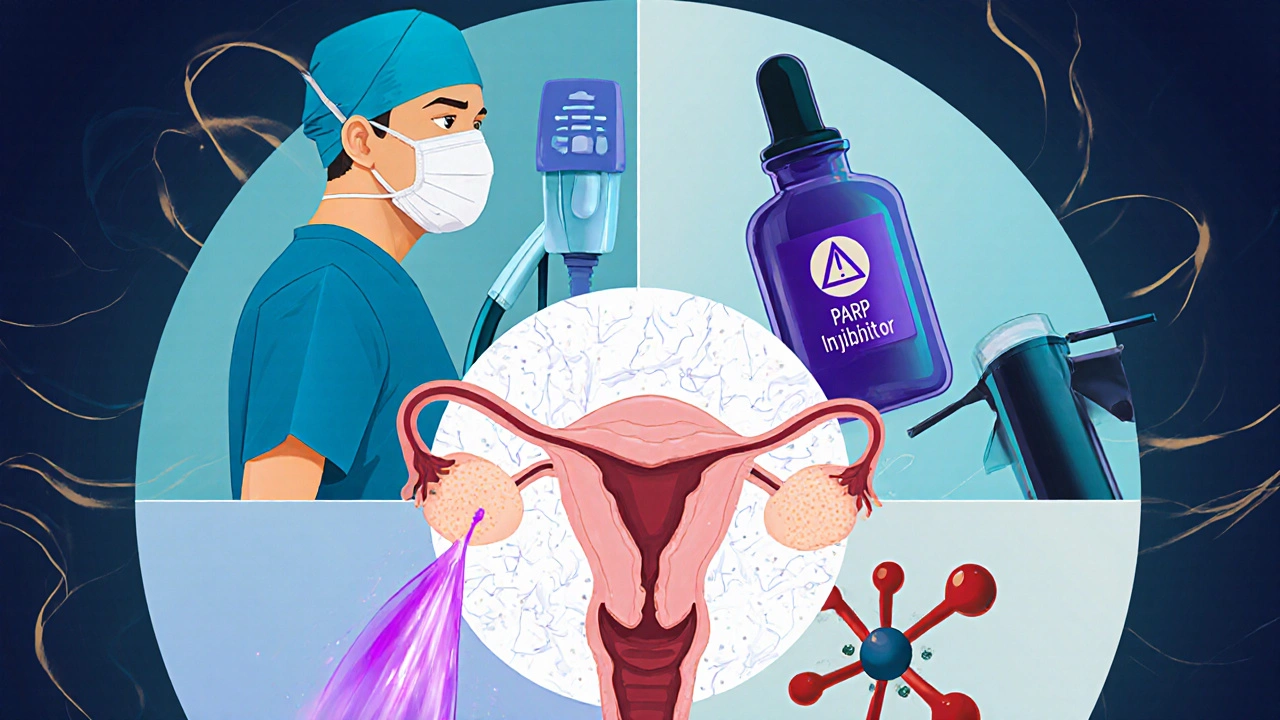Ovarian Cancer Treatment Pathway Planner
Facing an ovarian cancer diagnosis feels like the ground shifting beneath you. You start asking, “What can I actually do to fight this?” The good news is that today’s treatment toolbox is richer than ever, offering several paths that can be combined for better outcomes. This guide walks you through every major option, shows where each fits in a typical care plan, and gives you practical tips to navigate side‑effects, costs, and decisions.
Quick Takeaways
- Early‑stage disease is usually managed with surgery followed by chemotherapy.
- Targeted agents such as PARP inhibitors are game‑changers for patients with BRCA or other DNA‑repair defects.
- Immunotherapy works for a small subset of tumors that express high PD‑L1 or have high mutational burden.
- Clinical trials give access to cutting‑edge drugs and often cover treatment costs.
- Support services-nutrition, counseling, genetic testing-boost quality of life and help tailor therapy.
What Is Ovarian Cancer?
Ovarian cancer is a malignant growth that starts in the ovaries, the female reproductive organs that produce eggs and hormones. It accounts for roughly 3% of all cancers in women but is responsible for more deaths because it’s often diagnosed at an advanced stage. According to the World Health Organization, about 313,000 new cases were recorded worldwide in 2023, and the five‑year survival rate jumps from 92% for stageI to under 30% for stageIV.
Surgery: The First Line of Attack
Historically, the cornerstone of curative intent is surgery. The goal is to remove as much tumor as possible-a concept called "optimal debulking." When surgeons can leave no visible disease larger than 1cm, patients tend to live longer.
- Types of surgery: Total abdominal hysterectomy with bilateral salpingo‑oophorectomy (TAH‑BSO) and omentectomy are most common. For early disease, a fertility‑preserving unilateral salpingo‑oophorectomy may be an option.
- Recovery: Hospital stay ranges from 3‑7days; full activity returns in 4‑6weeks.
- Risks: Bleeding, infection, bowel or bladder injury, and menopause‑related symptoms if both ovaries are removed.
Surgeons now often use minimally invasive laparoscopy for early‑stage tumors, which reduces pain and shortens recovery.
Chemotherapy: The Workhorse
Chemotherapy is a systemic treatment that attacks rapidly dividing cells throughout the body. The standard regimen for ovarian cancer is a combination of a platinum compound (carboplatin) and a taxane (paclitaxel). This duo is given every three weeks for six cycles in most cases.
- Why platinum? It creates DNA cross‑links that cancer cells struggle to repair.
- Why taxane? It stabilizes microtubules, halting cell division.
- Side‑effects: Nausea, fatigue, low blood counts, peripheral neuropathy, and hair loss. Modern anti‑emetics and growth‑factor support have made these more manageable.
For patients who can’t tolerate IV infusion, intraperitoneal (IP) chemotherapy delivers the drugs directly into the abdominal cavity and has shown a modest survival advantage, though it’s used less often due to technical challenges.
Targeted Therapy: Hitting Cancer’s Weak Spots
Targeted agents block specific molecules that drive tumor growth. Two major classes dominate ovarian cancer care.
PARP Inhibitors
PARP inhibitors (e.g., olaparib, niraparib, rucaparib) exploit a DNA‑repair flaw common in tumors with BRCA1/2 mutations or homologous recombination deficiency (HRD). By inhibiting the poly‑ADP‑ribose polymerase enzyme, they prevent cancer cells from fixing single‑strand breaks, leading to cell death.
- Who benefits? Patients with germline or somatic BRCA mutations, and increasingly those with HRD‑positive tumors identified by a companion diagnostic.
- Usage: As maintenance therapy after response to platinum‑based chemotherapy, extending progression‑free survival by up to 18months.
- Side‑effects: Anemia, nausea, fatigue, rare pneumonitis.
Angiogenesis Inhibitors
Bevacizumab, a monoclonal antibody that blocks VEGF, cuts off the tumor’s blood supply. It’s approved in combination with chemotherapy for frontline treatment and as maintenance for recurrent disease.
- Benefit: Adds about 2‑3months of progression‑free survival in advanced cases.
- Risks: Hypertension, proteinuria, delayed wound healing-so surgeons often pause the drug before any operation.

Immunotherapy: Awakening the Body’s Defenses
Immunotherapy harnesses the immune system to recognize and kill cancer cells. Checkpoint inhibitors such as pembrolizumab have shown activity in a small subset of ovarian cancers with high PD‑L1 expression or microsatellite instability (MSI‑H).
- Current role: Mostly in clinical trials or as a later‑line option after standard therapies fail.
- Side‑effects: Immune‑related colitis, thyroiditis, skin rash-generally manageable with steroids.
Hormone Therapy: A Quiet Player
Some ovarian tumors express estrogen or progesterone receptors. In such cases, hormonal agents like letrozole (an aromatase inhibitor) or tamoxifen can slow tumor growth, especially in recurrent, low‑grade serous cancers.
- When used: As maintenance after chemotherapy or for patients who cannot tolerate cytotoxic drugs.
- Side‑effects: Mild hot flashes, joint pain, bone density loss-often less severe than chemotherapy.
Radiotherapy: Sparing the Spotlight
While not a primary treatment for ovarian cancer, radiation can palliate symptoms such as painful bone metastases or localized tumor recurrence. Advanced techniques like stereotactic body radiotherapy (SBRT) deliver high doses with minimal surrounding tissue damage.
Clinical Trials: Access to the Cutting Edge
Clinical trials give patients the chance to receive novel drugs before they hit the market. In 2024, over 600 ovarian‑cancer-specific trials were recruiting worldwide, spanning PARP‑inhibitor combinations, next‑generation immunotherapies, and gene‑editing approaches.
- How to find one: Use ClinicalTrials.gov, ask your oncologist, or check cancer center websites.
- Cost: Most trials cover the investigational drug and related procedures; travel and supportive care may still be an out‑of‑pocket expense.
- Considerations: Review eligibility criteria carefully-many trials require specific genetic markers or performance status.
Personalizing Treatment: The Role of Genetic Testing
Testing for BRCA1, BRCA2, and broader HRD panels informs whether PARP inhibitors will be effective. Additionally, next‑generation sequencing can uncover rare targetable alterations such as KRAS, PIK3CA, or NTRK fusions, opening doors to off‑label use of approved drugs.
Genetic counseling is recommended before and after testing to interpret results and discuss familial implications.

Managing Side‑Effects: Staying on Track
All therapies bring challenges. Here are practical tips that have helped many patients stay on their regimen.
- Nutrition: Small, frequent meals, ginger tea for nausea, and protein shakes to combat muscle loss.
- Fatigue: Light exercise (walking, yoga) improves energy levels; schedule rest periods during high‑toxicity weeks.
- Peripheral neuropathy: Use cooling gloves during paclitaxel infusions, take vitamin B12 supplements, and limit alcohol.
- Emotional health: Join support groups, consider cognitive‑behavioral therapy, and lean on family for practical tasks.
Putting It All Together: A Typical Care Path
Below is a simplified flowchart of how most clinicians sequence the different options. Individual plans will vary based on stage, genetics, performance status, and personal preferences.
| Phase | Primary Modality | Typical Goal | Common Follow‑Up |
|---|---|---|---|
| Initial | Surgery (optimal debulking) | Remove visible disease | Pathology, staging, genetic testing |
| Adjuvant | Platinum‑taxane chemotherapy | Kill microscopic residual cells | Assess response, start maintenance consideration |
| Maintenance | PARP inhibitor (if BRCA/HRD) or bevacizumab | Prolong progression‑free survival | Regular imaging, blood counts, manage toxicity |
| Recurrence | Second‑line chemo, targeted agents, clinical trial | Control disease, improve quality of life | Symptom management, re‑biopsy for new mutations |
Financial Considerations and Insurance
Cost is a real concern. Chemotherapy regimens can run $10,000-$30,000 per cycle, while PARP inhibitors often exceed $200,000 a year. Many insurance plans now list these drugs under specialty pharmacy tiers, and patient‑assistance programs from manufacturers can cover up to 90% of out‑of‑pocket costs.
Ask your oncology team for a financial navigator early; they can help submit prior‑authorizations, locate grants, and estimate total expenses.
Living Beyond Treatment
Survivorship isn’t just about scans; it’s about returning to daily life.
- Follow‑up schedule: Physical exam and CA‑125 blood test every 3months for 2years, then every 6months up to 5years.
- Exercise: Low‑impact activities improve cardiovascular health and reduce fatigue.
- Fertility: If you preserved eggs or embryos before treatment, discuss timing with a reproductive specialist.
- Psychosocial support: Counseling and peer groups lessen anxiety about recurrence.
Frequently Asked Questions
What is the difference between adjuvant and neoadjuvant chemotherapy?
Adjuvant chemotherapy is given **after** surgery to eliminate remaining cancer cells, while neoadjuvant chemotherapy is administered **before** surgery to shrink the tumor, making an optimal debulking more achievable.
Can I preserve my fertility if I need surgery?
Yes, for early‑stage disease a unilateral salpingo‑oophorectomy (removing only one ovary) can preserve fertility, and egg or embryo freezing can be done before any treatment that threatens ovarian function.
How do I know if I’m a candidate for PARP inhibitor therapy?
Your tumor must show a BRCA1/2 mutation or broader homologous recombination deficiency. A genetic test performed on the tumor tissue or blood can confirm eligibility.
Are there any lifestyle changes that improve treatment outcomes?
Maintaining a balanced diet, staying active, and managing stress have been associated with better tolerance of therapy and possibly longer survival, though they do not replace medical treatment.
What should I expect during a follow‑up visit after finishing treatment?
Your doctor will review physical exam findings, order imaging (often CT or PET), and check tumor markers like CA‑125. They’ll also discuss any lingering side‑effects and plan survivorship care.
Next Steps for You
Take these actions today to move forward with confidence:
- Schedule a genetics appointment to test for BRCA/HRD status.
- Ask your oncologist for a written summary of recommended treatment phases.
- Check ClinicalTrials.gov for any open studies that match your tumor profile.
- Connect with a financial navigator at your cancer center to explore assistance programs.
- Join a local or online ovarian‑cancer support group for peer advice and emotional backup.
Remember, every woman’s journey is unique. By understanding the full set of options-from surgery to cutting‑edge trials-you can partner with your medical team to craft a plan that aligns with your health goals and life priorities.

Vani Prasanth
October 10, 2025 AT 22:02Thanks for putting together such a thorough guide. It really helps to see the whole picture from surgery all the way to survivorship. I especially liked the sections on financial aid and support groups – those are often overlooked. The step‑by‑step table makes it easy to explain to family members who might be confused. It’s also reassuring to know there are options like fertility‑preserving surgery for younger patients. The emphasis on genetic testing is spot on; catching a BRCA mutation early can change the whole treatment plan. Your reminder to talk to a financial navigator early saved me a lot of stress last year. Overall, this is a wonderful resource for anyone navigating a diagnosis.
Zach Westfall
October 14, 2025 AT 00:02Wow this guide screams clarity and honesty – love it.
Pranesh Kuppusamy
October 17, 2025 AT 02:02One cannot overlook the hidden layers of the oncology ecosystem where data, consent, and the silent orchestration of pharmaceutical interests converge. While the therapeutic arsenal expands, the subtle trade‑offs between efficacy and quality of life remain a constant whisper behind every protocol. The guide rightly balances optimism with realism, yet the reader must stay vigilant about the gray zones of clinical trial enrollment criteria that often filter out the very patients who might benefit most. A measured skepticism is healthy, especially when navigating insurance denials that hinge on nuanced interpretations of "standard of care." Ultimately, informed patient agency is the true compass in this labyrinth.
Brandon Leach
October 20, 2025 AT 04:02Great summary.
Alison Poteracke
October 23, 2025 AT 06:02I found the simple language really helpful – no medical jargon to get lost in. The bullet points on side effects gave me quick ideas on what to talk to my doctor about.
Marianne Wilson
October 26, 2025 AT 08:02While the guide is comprehensive, it glosses over the fact that many of these cutting‑edge drugs are still out of reach for patients without premium insurance. The average cost of a PARP inhibitor can bankrupt a family even with assistance programs. Also, the survival statistics quoted often ignore the selection bias of clinical trial populations. A more critical look at the socioeconomic disparities would make this resource truly balanced.
Patricia Bokern
October 29, 2025 AT 10:02Okay but seriously, the drama of fighting ovarian cancer is like starring in your own thriller where the villain is a microscopic cell and the hero- you- has to juggle chemo, insurance, and a Netflix binge schedule. The guide is my cheat‑sheet for the plot twists.
Garrett Gonzales
November 1, 2025 AT 12:02From a clinical perspective, the treatment algorithm for ovarian cancer can be broken down into distinct phases, each with specific objectives and evidence‑based interventions. Phase 1 typically involves optimal cytoreductive surgery, aiming to leave no residual disease greater than 1 cm; data consistently show improved overall survival when this goal is achieved. Following surgery, Phase 2 introduces platinum‑based chemotherapy-most commonly carboplatin combined with a taxane such as paclitaxel-administered every three weeks for six cycles, which remains the cornerstone of adjuvant therapy. When a BRCA mutation or homologous recombination deficiency (HRD) is identified, Phase 3 incorporates PARP inhibitors as maintenance, a strategy supported by multiple phase III trials demonstrating up to an 18‑month extension in progression‑free survival. In parallel, anti‑angiogenic agents like bevacizumab may be added, particularly in advanced disease, to further disrupt tumor vascularization. Should the disease recur, Phase 4 explores second‑line options: additional platinum rechallenge, alternative chemotherapeutic agents, targeted therapies based on molecular profiling, or enrollment in clinical trials, which continue to push the therapeutic frontier. Immunotherapy, though currently limited to a subset of tumors with high PD‑L1 expression or MSI‑H status, is an emerging avenue warranting consideration in refractory settings. Throughout all phases, vigilant management of side effects-nausea, neuropathy, hematologic toxicity-through supportive care measures is essential to maintain dose intensity and quality of life. Finally, the survivorship phase emphasizes regular surveillance with CA‑125 testing and imaging, lifestyle interventions, and psychosocial support to address the long‑term physical and emotional sequelae of treatment. This structured, phase‑specific approach ensures that therapy is both personalized and grounded in the latest evidence.
Aman Deep
November 4, 2025 AT 14:02Whoa, such a kaleidoscope of options! 🎨 The guide’s colorful layout actually mirrors the rainbow of treatments-surgery, chemo, targeted magic, and that glittering promise of clinical trials. It’s like a Bollywood blockbuster where each act brings a new twist, and the supporting cast of nutritionists and counselors save the day.
Herman Bambang Suherman
November 7, 2025 AT 16:02Clear steps, concise advice-exactly what patients need when decisions pile up.
Meredith Blazevich
November 10, 2025 AT 18:02Reading the long expert overview reminded me of how crucial it is to keep hope alive while staying grounded in facts. The breakdown of each phase makes it feel less like an endless maze and more like a road map with checkpoints. I appreciate the honesty about side‑effects, because acknowledging the tough parts honestly prepares you mentally. The mention of support groups and financial counseling adds a human touch that often gets lost in clinical jargon. Overall, the guide balances detail with empathy, which is exactly what patients need right now.
Nicola Gilmour
November 13, 2025 AT 20:02Let’s keep this momentum going! If you’re feeling overwhelmed, remember that every small step-like scheduling that genetics appointment-moves you forward. Share your progress with the community; your story could be the spark someone else needs.
Darci Gonzalez
November 16, 2025 AT 22:02Going through this guide feels like having a knowledgeable friend by your side. Take one piece at a time, lean on the resources mentioned, and don’t hesitate to ask your care team for clarification whenever something feels murky.